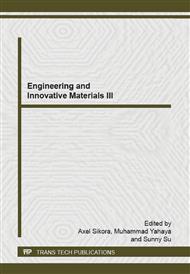[1]
Jeong, S.S., H.C., et. al.: Stable Aqueous Based Cu Nanoparticle Ink for Printing Well-Defined Highly Conductive Features on a Plastic Substrate. Langmuir,. 27(6): (2011), pp.3144-3149.
DOI: 10.1021/la104136w
Google Scholar
[2]
Zhang, D., et. al.: Synthesis of Ultralong Copper Nanowires for High-Performance Transparent Electrodes (Journal of the American Chemical Society, 2012)134: pp.14283-14286.
DOI: 10.1021/ja3050184
Google Scholar
[3]
Vahid Safarifard, A.M.: Sonochemical syntheses of a nano-sized copper(II) supramolecule as a precursor for the synthesis of copper(II) oxide nanoparticles (Ultrasonics Sonochemistry, 2011) 19: pp.823-829.
DOI: 10.1016/j.ultsonch.2011.12.013
Google Scholar
[4]
Zhong, Z. e. a.: Facile Solvothermal Synthesis of Porous Cubic Cu Microparticles as Copper Catalysts for Rochow Reaction (Applied Materials and Interfaces, 2012) 4(3): pp.1295-1302.
DOI: 10.1021/am3002605
Google Scholar
[5]
Galletti, A.A., C.; Marraccib, M.; Piccinelli, F.; Tellini, B.: Novel microwave-synthesis of Cu nanoparticles in the absence of any stabilizing agent and their antibacterial and antistatic applications (Applied Surface Science, 2013) 280: pp.610-618.
DOI: 10.1016/j.apsusc.2013.05.035
Google Scholar
[6]
J. van den Meerakker, J.B.: On the Mechanism of Electroless Plating (Journal of Applied Electrochemistry, 1990) 20: pp.85-90.
Google Scholar
[7]
Liu, Z.Y., Y.; et. al.: Synthesis of Copper Nanowires via a Complex-Surfactant-Assisted Hydrothermal Reduction Process (Journal of physical Chemistry B, 2003) 107: pp.12658-12661.
DOI: 10.1021/jp036023s
Google Scholar
[8]
Yu Chang, et. al., Large-Scale Synthesis of High-Quality Ultralong Copper Nanowires (Langmuir, 2005) 21(125): pp.3746-3748.
DOI: 10.1021/la050220w
Google Scholar
[9]
Mott, D., et. al.: Synthesis of Size-Controlled and Shaped Copper Nanoparticles (Langmuir, 2007) 23(10): pp.5740-5745.
DOI: 10.1021/la0635092
Google Scholar
[10]
Yanhu Wei, et. al., Synthesis of Stable, Low-Dispersity Copper Nanoparticles and Nanorods and Their Antifungal and Catalytic Properties. (Journal of Physical Chemistry, 2010) 114(37): p.15612–15616.
DOI: 10.1021/jp1055683
Google Scholar
[11]
Wei, W.L., y.; Chen, W.; Chen, S.: One-Pot Synthesis, Photoluminescence, and Electrocatalytic Properties of Subnanometer-Sized Copper Clusters (Journal of the American Chemical Society, 2011) 133: p.2060-(2063).
DOI: 10.1021/ja109303z
Google Scholar
[12]
Deng, D., et. al.: Copper Nanoparticles: Aqueous Phase Synthesis and Conductive Films Fabrication at Low Sintering Temperature. (Applied Materials and Interfaces, 2013) 5: pp.3839-3846.
DOI: 10.1021/am400480k
Google Scholar
[13]
Yang, H.J.H., S.Y.; Tuan, H.Y., Self-Seeded Growth of Five-Fold Twinned Copper Nanowires: Mechanistic Study, Characterization, and SERS Applications (Langmuir, 2014) 40: pp.602-610.
DOI: 10.1021/la4036198
Google Scholar


